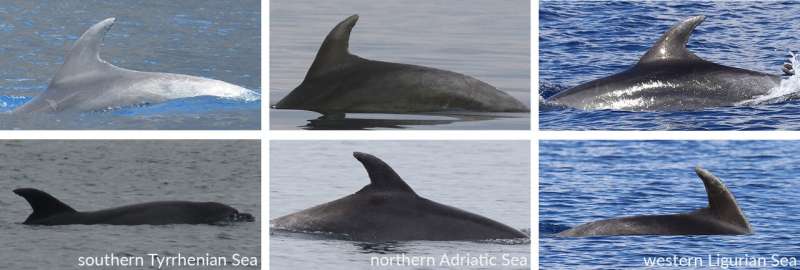Prešeren photographed in Tyrrhenian Sea, northern Adriatic Sea and Ligurian Sea. Credit: University of St Andrews
A team of researchers, including experts from the University of St Andrews, have documented the longest recorded movement in an inshore bottlenose dolphin—an incredible journey of 2,053 km (approximately 1,276 miles).
The study, "The longest recorded movement of an inshore common bottlenose dolphin (Tursiops truncates) of the research on the world record-holding dolphin," is published in Mammalian Biology.
In February 2020, researchers from the University's Sea Mammal Research Unit (SMRU) and Morigenos, the Slovenian Marine Mammal Society, photographed a dolphin off the coast of Piran, Slovenia, that had not been sighted there before.
They named it Prešeren, due to the fact it was spotted on Prešeren Day, a Slovenian national holiday dedicated to poet France Prešeren. He was seen again in the area a month later.
The following year, lead author Dr. Tilen Genov by chance attended an online talk by an Italian colleague, Dr. Francesca Blasi from Filicudi WildLife Conservation, and spotted a fin he recognized in one of the photographs.
After a careful examination of all available photographs, the researchers jointly determined beyond doubt that this was the same dolphin, which was originally called Lino by Italian researchers. Prešeren had to travel at least 1,251 km to get to Slovenia from the Tyrrhenian Sea, north of Sicily, breaking all the existing Mediterranean records, and most world records too.
But the surprises didn't end there. After they presented their preliminary results at an online international conference, the researchers were contacted by a team from Delfini Del Ponente, who study dolphins in the Ligurian Sea, Italy. They had photographed the same dolphin as well, just six months after he was observed off Piran.
This time Prešeren had to travel a minimum of 2,053 km (the shortest possible path), which is the longest recorded movement in a so-called inshore ecotype of bottlenose dolphins, and the second longest for the species overall. The only recorded movement that was longer was one of an 'offshore' bottlenose dolphin ecotype, tracked through a satellite transmitter following a period of rehabilitation in human care.
Dr. Genov said, "Bottlenose dolphins are generally thought of as a relatively resident species, with strong fidelity to their home area. This is mostly true, but our new findings, together with a review of the existing literature that we carried out, show that this species is much more mobile than we previously thought."
"This is important in relation to gene flow among populations, which is crucial in the long-term conservation of this species, but it also demonstrates the importance of international collaboration in conserving biodiversity. Such findings contribute to a better understanding of species, which indirectly leads to a better understanding of marine ecosystems."
More information: Tilen Genov et al, The longest recorded movement of an inshore common bottlenose dolphin (Tursiops truncatus), Mammalian Biology (2022). DOI: 10.1007/s42991-022-00316-5
Journal information: Mammalian Biology
Provided by University of St Andrews
























